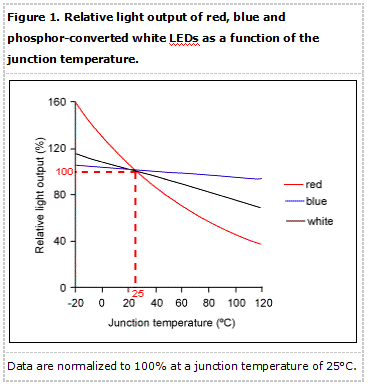How are LEDs affected by heat?
In general, the cooler the environment, the higher an LED's light output will be. Higher temperatures generally reduce light output. In warmer environments and at higher currents, the temperature of the semiconducting element increases. The light output of an LED for a constant current varies as a function of its junction temperature. Figure 1 shows the light output of several LEDs as a function of junction temperature. The temperature dependence is much less for InGaN LEDs (e.g., blue, green, white) than for AlGaInP LEDs (e.g., red and yellow).
How are LEDs affected by heat?
Most LED manufacturers publish curves similar to those in Figure 9 for their products, and the precise relationships for various products will be different. It is important to note that many of these graphs show light output as a function of junction temperature and not ambient temperature. An LED operating in an ambient environment at normal room temperature (between 20°C and 25°C) and at manufacturer-recommended currents can have much higher junction temperatures, such as 60°C to 80°C. Junction temperature is a function of:
Some system manufacturers include a compensation circuit that adjusts the current through the LED to maintain constant light output for various ambient temperatures. This can result in over driving LEDs in some systems during extended periods of high ambient temperature, potentially shortening their useful life.
· ambient temperature
· current through the LED
· amount of heat sink(thermal interface materials are included) material in and around the LED
Generally, the lighting specifier does not need to be aware of these relationships; the maker of an LED lighting system should incorporate appropriate heat sinking and other compensatory mechanisms. The system manufacturer should then provide a range of permissible operating temperatures within which acceptable operation will be expected.

Prolonged heat can significantly shorten the useful life of many LED systems. Higher ambient temperature leads to higher junction temperatures, which can increase the degradation rate of the LED junction element, possibly causing the light output of an LED to irreversibly decrease over the long term at a faster rate than at lower temperatures.
Controlling the temperature of an LED is, therefore, one of the most important aspects of optimum performance of LED systems.
 中文
中文



.png) Search
Search


 >
>  Return to List
Return to List